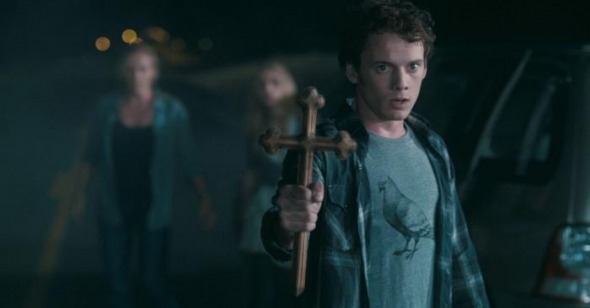Monday Hangover:
Fright Night
by Michael Koresky and Adam Nayman
Forget all the majestically splashed buckets of gore. Forget the unexpectedly rousing highway car chase, in which a vampire proves to be as malleably invincible as a T-1000. Put aside for now even those jarring ghastly vampire grins as mile-wide as Dolly Parton’s new mouth. What Craig Gillespie’s Fright Night remake really excels at is exposition. Early in the film, high-school nerd Ed (Hollywood geek-king Christopher Mintz-Plasse of Superbad) is explaining to his former best buddy, and the film’s protagonist, Charley (Anton Yelchin), that he strongly suspects Charley is living next door to a vampire—and not a vampire in the sparkly 2011 sense, but of the classical, Bram Stoker variety. But Gillespie stages the long, dialogue-heavy sequence not in, say, the school cafeteria or an overly set-designed teen bedroom, but rather in the windy interiors of a Las Vegas suburban tract home at dusk, filmed in magnificently murky gray-blue by Javier Agguiresarobe (yes, he shot some Twilight movies, but also last decade’s best-in-show ghost story The Others). As Ed and Charley creep through the echoey rooms, we glean nearly all the film’s pertinent information, both in terms of the new cold-blooded threat on the block and these two kids’ foundering friendship: Charley was also once a role-playing dorkus maximus and has left Ed behind since he emerged from acres of acne to baby-handsome borderline coolness (Mintz-Plasse’s well-practiced lisping impudence and Yelchin’s fragile stabs at indifference are perfectly played here).
Once its ground rules are set, Fright Night is a bat out of hell, plowing ahead with bloody abandon. Not remembering the original Tom Holland film particularly well, I can’t say whether its structure is borrowed; regardless, Gillespie’s version, though clearly a product geared more toward attention-deficit millennials than lovers of traditional creepshows, is often a hoot. And let’s give credit where it’s due: Colin Farrell, first appearing on his front lawn in a seductive glower and matching black tank-top, is a vamp of the highest order—the role gives the Irishman a chance to strut his sundry stuff; his sexy swagger and comic chops are both on full view. But this is also where the film’s swift narrative economy becomes a liability: if only Gillespie allowed any space for Farrell to loosen up. Unfortunately Fright Night only has room for one real eccentric, its official comic side character, David Tennant’s seemingly phony baloney vampire hunter Vegas act Peter Vincent (Roddy McDowall’s late-night horror host in the original). Yet once Fright Night devolves into a bombastic CGI-spewing bloodbath, this Criss Angel–esque Vincent is revealed as perhaps the film’s true presiding spirit, the patron saint of excess. —MK
“The patron saint of excess”—I like that, and I liked Tennant, whose day-job as Dr. Who occasions a much milder strain of eccentricity. The conception of Peter Vincent as a premature show business wreck—instead of a doddering dear à la Roddy McDowall—is one of Fright Night 2.0’s best ideas, since it makes the story less about nostalgia: instead of wrestling with an affection for old horror movies, the characters here spend their time and brainpower thinking how to best extricate themselves from a lean, ruthless, present-tense version. I didn’t mind the film’s “swift narrative economy,” as it seemed an improvement on both the plodding innocuousness of so many “youth”-oriented genre pictures (here’s looking at you, Twilight) or the sadistic distension of Saw 9, Final Destination 12, et al., movies that are only invested in their retch-inducing money shots. Fright Night is surely gory and grotesque (the self-division of Mintz-Plasse’s character is visualized nicely via a botched, but still 70-percent effective, decapitation), but it’s not cruel: It keeps the narrative stakes (sorry) high without overstepping its ambitions as a pleasantly feckless jolt-dispensing machine.
As for Farrell, he may not have a lot of space to stretch out but that doesn’t keep him from acting like he owns the place, and the film, and he does. I’m a great fan of this failed leading man’s recent character work (he was better than Jeff Bridges in Crazy Heart, and fully inhabited his combed-over-creep cameo in Horrible Bosses) and he gives Jerry a sly, watchful bearing that’s just right for a career vampire who’s toughed it out over decades (centuries?) of suspicious neighbors and dwindling food supply. Chris Sarandon played Jerry with more magisterial creepiness (befitting the original’s Hammer Horror leanings), but Farrell opts for self-satisfied sleaze, simultaneously parodying the romantic qualities ascribed to pop-culture vampires from Lestat to Angel and sending up his own image as an unrepentant Hollywood lothario. The scene where Jerry tries to get himself invited in to Charley’s kitchen for a six pack is tenser and funnier than it should be considering that the film has barely even gotten started and we know there’s no way anything significant is going to happen; as Jerry realizes that the kid is on to him, Farrell shifts from ingratiation to intimidation in a way that suggests the character is amusing himself to make up for the fact that he’s going to have to wait a little while to get what he really wants. I’m not crazy about the way Fright Night descends into loud, blurry, 3-D-battered set pieces (those pop-out close-ups of Jerry’s feral vampire face are some seriously sub-spook-house rollercoaster shit). But when was the last time that a horror film—franchise entry, prequel, remake, or other—also contained one of the most accomplished comic performances of the year? —AN
